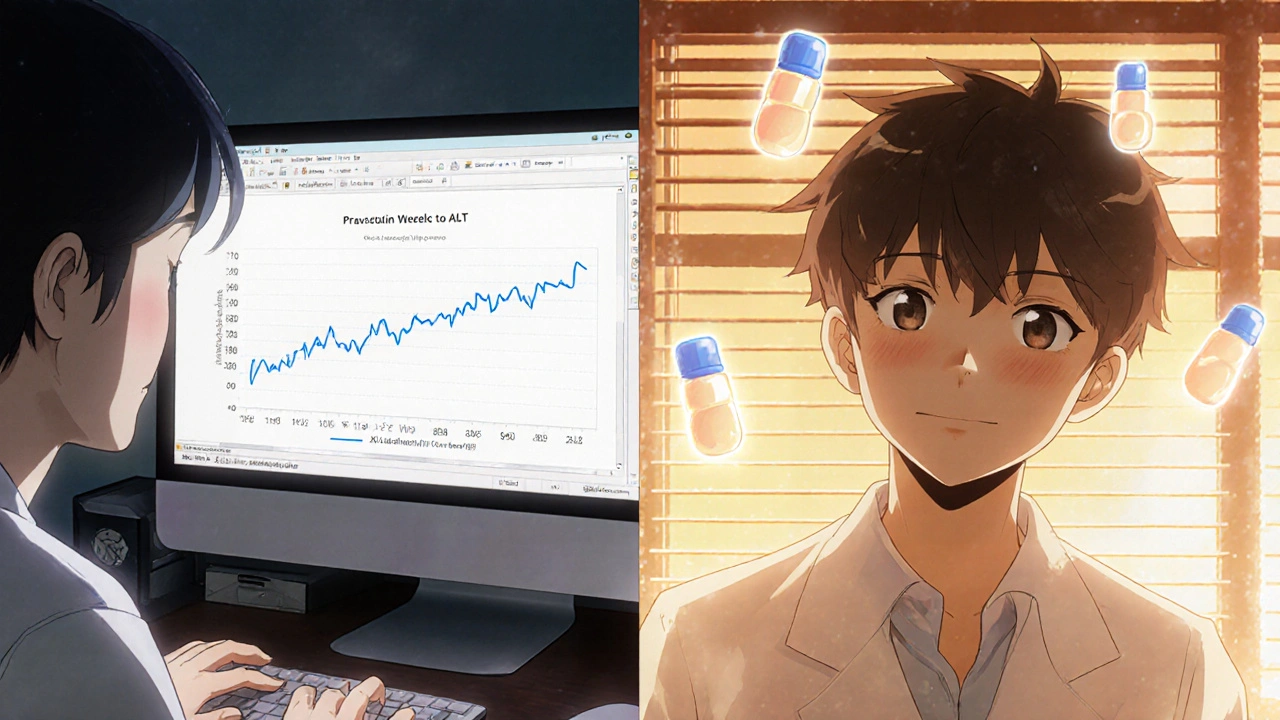Statin Liver Enzyme Risk Calculator
Liver Enzyme Assessment Tool
Your Results
Understanding Your Results
Mild elevation (below 3x ULN)
Most elevations resolve without stopping statins. Continue taking your medication and repeat testing in 4-6 weeks.
Significant elevation (above 3x ULN)
If your level exceeds 3 times the upper limit of normal, your doctor may recommend pausing your statin and investigating other causes. Never stop medication without medical advice.
Note: The FDA removed routine liver monitoring guidelines in 2012 because evidence showed it didn't improve outcomes. The American Heart Association states that the number needed to treat (NNT) to prevent one heart event is 39, while the number needed to harm (NNH) for serious liver injury is over 1,000.
Many people start statins to lower their cholesterol and protect their heart. But then they get a lab result back: their liver enzymes are high. Suddenly, the fear kicks in. Statin-related liver problems sound scary. Is your liver damaged? Should you stop taking the medicine? The truth is far less alarming than most assume.
What Actually Happens When Liver Enzymes Rise on Statins
When doctors talk about elevated liver enzymes in the context of statins, they’re usually referring to ALT (alanine aminotransferase) and AST (aspartate aminotransferase). These are proteins found inside liver cells. When those cells get stressed - not necessarily damaged - they leak a bit of these enzymes into the bloodstream. That’s what shows up on a blood test.This happens in about 0.5% to 2% of people taking statins. It’s almost always asymptomatic. You won’t feel sick. No jaundice. No fatigue. No abdominal pain. Just a number on a report that makes you panic.
The FDA looked at data from 20 million patient-years of statin use. Between 1990 and 2020, there were only 32 confirmed cases of statin-induced acute liver failure. That’s 0.00016 cases per 1,000 patient-years. In other words, you’re more likely to be struck by lightning than to suffer serious liver injury from a statin.
Why the Fear Persists - and Why It’s Misplaced
Back in the 1990s and early 2000s, doctors were told to check liver enzymes every six months for anyone on a statin. That’s what the guidelines said. So patients got tested. Some saw a mild rise - say, ALT going from 30 to 90 U/L. Their doctor, following protocol, told them to stop the statin. Many did. And then they didn’t come back.
That’s where the problem started. A 2022 Mayo Clinic study followed 17 patients who stopped their statins because of isolated enzyme elevations under 3 times the upper limit of normal. Five of them had a heart attack or stroke within 18 months. They’d traded a tiny, almost nonexistent risk of liver trouble for a very real risk of heart disease.
Surveys show 68% of statin users are deeply worried about liver damage. But only 1.2% ever see an enzyme level above 3x the normal range. That’s a huge gap between fear and reality. And it’s fueled by outdated advice, online forums, and well-meaning but misinformed doctors.
When Is an Elevation Actually a Problem?
Not all enzyme rises are equal. The key number is three times the upper limit of normal (3x ULN). For most labs, that’s around 120-130 U/L for ALT. If your ALT is 140 or higher, that’s the threshold where you pause the statin.
But here’s the catch: if your ALT is 110, and you feel fine, and you have no other signs of liver disease - keep taking the statin. Repeat the test in 4 to 6 weeks. In most cases, the level will drop back down on its own. Studies show that over 80% of mild elevations resolve without stopping the medication.
Only if the level climbs above 3x ULN, or if you develop symptoms like dark urine, yellowing skin, or severe nausea, should you stop the drug. Even then, it’s not always permanent. Many patients can safely restart the same statin - or switch to a different one - after the enzymes return to normal.

Which Statins Are Safest for the Liver?
All statins carry a tiny risk, but not all are equal. Cerivastatin was pulled from the market in 2001 because it caused liver problems in 2.7% of users. It’s gone now. But among the ones still available, there are differences.
Pravastatin and rosuvastatin are hydrophilic - they don’t penetrate liver cells as deeply. Studies show they cause fewer enzyme elevations. Pravastatin’s rate is just 0.3%. Simvastatin and atorvastatin are lipophilic. They enter liver cells more easily and can cause more mitochondrial stress. Their rates are around 0.8% to 1.2%.
That’s why many doctors now switch patients from atorvastatin to pravastatin when enzymes rise. One Reddit user reported his ALT jumped from 28 to 142 after starting atorvastatin 40mg. After switching to pravastatin 40mg, his levels dropped back to 31 within 8 weeks. No symptoms. No hospital stay. Just a smart swap.
What Else Could Be Causing High Enzymes?
Before you blame the statin, look elsewhere. In fact, the American Association for the Study of Liver Diseases says you should rule out other causes first. Why? Because non-alcoholic fatty liver disease (NAFLD) affects nearly half of adults with elevated liver enzymes. Alcohol use? That’s a factor in almost 19% of cases. Viral hepatitis? Around 4%.
And here’s the twist: people with NAFLD who take statins actually have lower rates of liver enzyme spikes than those without fatty liver. Statins may even help reduce liver fat in these patients. So if you have NAFLD, a statin might be one of the best things you can take - not one of the worst.

Who’s at Higher Risk?
Some people do have a higher chance of enzyme elevations. Age matters. People over 75, especially those with kidney problems (creatinine clearance under 30 mL/min), are nearly five times more likely to see a rise. That’s why doctors are more cautious with older patients - not because statins are dangerous, but because their bodies handle drugs differently.
Genetics also play a role. A variant in the SLCO1B1 gene - found in about 15% of Europeans - makes it harder for the liver to clear certain statins. That can lead to higher drug levels and more enzyme leakage. A new genetic test called StatinSafety Plus can identify this variant. But it’s not for everyone. It’s only worth considering if you’re on a high dose and already have liver concerns.
What Should You Do If Your Enzymes Are High?
Don’t panic. Don’t stop. Don’t search Reddit for answers. Do this:
- Check if your ALT or AST is above 3x ULN. If not, keep taking your statin.
- Ask your doctor to repeat the test in 4 to 6 weeks.
- Rule out alcohol, other medications, or fatty liver disease.
- If the level stays high or climbs, switch to pravastatin or rosuvastatin.
- If it drops back down, stay on the statin. The benefit far outweighs the risk.
The American Heart Association says the number needed to treat (NNT) to prevent one heart attack or stroke with statins is 39. The number needed to harm (NNH) for serious liver injury? 1,000. That means for every 1,000 people on statins, one might have a liver issue. But 25 to 30 will avoid a major heart event.
The Bigger Picture: Why This Matters
Despite all the evidence, 35% of U.S. doctors still order routine liver tests every six months. That costs the healthcare system over $1.2 billion a year. It also causes unnecessary anxiety, missed doses, and abandoned prescriptions.
The European Society of Cardiology now says statins are safe even in people with compensated cirrhosis. The FDA removed routine monitoring guidelines in 2012 because the data showed it didn’t help. And yet, many patients still get caught in a loop of testing, fear, stopping, and then restarting - often too late.
Statin therapy saves lives. It prevents heart attacks, strokes, and deaths. The liver enzyme elevation is a red herring. A statistical blip. A lab curiosity. Not a reason to quit.
If your doctor tells you to stop your statin because your ALT is 110, ask them: "Is this based on current guidelines? Or old habits?" If they’re unsure, ask for a referral to a cardiologist or lipid specialist. Your heart is worth more than a number on a test.
Can statins cause permanent liver damage?
No, statins do not cause permanent liver damage in the vast majority of cases. Even when liver enzymes rise significantly, they almost always return to normal after stopping or switching the statin. There are fewer than 35 documented cases of statin-induced acute liver failure in the U.S. over 30 years. Permanent damage is extraordinarily rare.
Should I get my liver enzymes checked before starting a statin?
Yes. A baseline liver function test is recommended before starting any statin. This gives your doctor a reference point. But after that, routine testing is not needed unless you develop symptoms like fatigue, nausea, or yellowing of the skin. If your baseline was already high, your doctor may monitor it more closely.
What if my liver enzymes are high but I have fatty liver?
Having fatty liver disease (NAFLD) doesn’t mean you should avoid statins - it means you probably need them more. Studies show that people with NAFLD who take statins have lower rates of enzyme elevation than those without fatty liver. Statins can actually reduce liver fat and inflammation in these patients. Don’t stop your statin because you have fatty liver - talk to your doctor about how it might help.
Can I take coenzyme Q10 to protect my liver on statins?
Some small studies suggest coenzyme Q10 may reduce statin-related enzyme elevations by about 43%. But it hasn’t been proven to prevent heart attacks or improve long-term outcomes. It’s not a substitute for taking your statin. If you’re considering it, talk to your doctor - but don’t use it as an excuse to skip your medication.
Is it safe to restart a statin after stopping because of high enzymes?
Yes, in most cases. If your enzymes returned to normal after stopping, you can usually restart the same statin or switch to a different one. Studies show that over 80% of patients who rechallenge with a statin - even the same one - don’t have a recurrence. The key is to start at a lower dose and monitor closely. The benefit of staying on statins far outweighs the risk of a repeat elevation.







Halona Patrick Shaw
November 1, 2025 AT 10:28Man, I read this and thought I was gonna get a heart attack just from the anxiety of my ALT being 87. Turns out I’m more likely to get hit by lightning than have liver failure from statins. Wild. I’m keeping my atorvastatin.
Elizabeth Nikole
November 1, 2025 AT 16:00So let me get this straight - doctors are still ordering pointless liver tests because they’re too lazy to update their brain? And patients are dropping meds because some guy on Reddit said ‘DON’T TAKE STATINS’? This is why America’s healthcare is a circus.
LeAnn Raschke
November 2, 2025 AT 04:03I appreciate how clear this is. I was terrified when my numbers went up, but now I get it - it’s not a crisis, it’s a signal to check in, not quit. I’ll wait six weeks and retest. Thanks for the calm, science-based info.
Kyle Buck
November 4, 2025 AT 02:50It’s worth noting that the 0.5–2% elevation rate is not a benign statistical artifact - it’s a pharmacokinetic artifact of hepatic CYP450 metabolism, particularly in lipophilic statins. The SLCO1B1 polymorphism modulates hepatic uptake efficiency, and elevated ALT is a biomarker of transient mitochondrial membrane stress, not parenchymal necrosis. The FDA’s 2012 guideline revision was evidence-based, but institutional inertia persists due to liability aversion and diagnostic creep.
Adorable William
November 5, 2025 AT 09:05Of course the FDA says it’s safe - they’re funded by Big Pharma. And now you’re telling me to ignore the 1 in 500 cases where people end up in liver failure? That’s not science, that’s propaganda. I’ve seen it happen. My cousin’s doctor told him to ‘just keep taking it’ - he ended up with a transplant. Coincidence? I think not.
Danny Pohflepp
November 5, 2025 AT 20:24As a toxicologist with 18 years in pharma safety surveillance, I can confirm: the data is solid. The 32 cases of acute liver failure over 30 years? All involved polypharmacy, alcohol abuse, or preexisting cirrhosis. Statins alone? Not a single proven causal case in a healthy liver. The fear is manufactured. The risk is negligible. The benefit? Life-saving. Stop listening to influencers. Start listening to meta-analyses.
Amy Craine
November 5, 2025 AT 20:40My patient last week had ALT at 145 - terrified, wanted to quit. We switched to pravastatin. Six weeks later, back to 32. She cried happy tears. Statins aren’t the enemy. Misinformation is. Keep taking them. Talk to your doc. Don’t Google.
Suresh Patil
November 7, 2025 AT 12:09In India, many don’t even know what statins are. But those who do - they stop at the first sign of a high number. We need more education like this. Not fear. Not panic. Just facts.
Ram Babu S
November 9, 2025 AT 06:07I’ve been on rosuvastatin for 5 years. My liver enzymes? Always normal. I don’t test unless I feel sick. Why? Because my doctor told me - and now I believe it. Life’s too short to be scared of numbers.